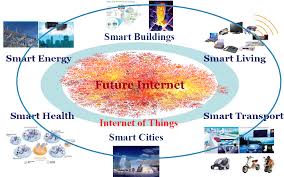Internet of Things (IoT) and the Challenges Ahead
What is the Internet of Things (IoT)?
The Internet of Things (IoT) is the technology that allows controlling and interconnecting of multiple physical devices through a network by employing powers of internet. The term was first coined by Kevin Ashton of Procter & Gamble in 1999.
Things in IOT refer to a wide variety of devices or equipment that contain electronic sensors and computer software to support exchange of data, interpret the date received and act automatically based on the instruction. The interconnectivity can be used to control a variety of devices such as vehicles, home appliances, electronic gates etc by instructions through internet. Each connected device maintains its own identity but co-operate for inter-operation within the internet infrastructure. These devices collect, analyze and act with the help of various existing technologies.
What are the features of the Internet of Things (IoT)?
The special feature of the Internet of Things (IoT) is that it permits integration of physical devices with computer based programs. This offers the feature of remote control without physical presence. The reduced human intervention and controllability over internet increase efficiency and accuracy of operation, saving of time and economic advantages. This permits the house owner to open the gate by sitting in the car itself or switch on the washing machine while returning from office. Thus the technology utilizes the powers of electronics, computers and internet.
What does the word ‘Things’ in the Internet of Things mean?
The word things in ‘Internet of Things’ may include biochips embedded in farm animals, heart monitoring implants in patients, control switches in thermal power or nuclear plants, automobiles with built in sensors, various switches in smart homes etc. There is no end to the list. Things stand for a mixture of hardware, software, data and service. IoT in general sense is a cyber-physical system.
How big is the Internet of Things business?
According to Boston Consultancy Group, $267 billion is expected to be spent on IoT technologies, services and products by 2020. $64.1 billion is expected to be generated from IoT applications and another $21.4 billion from IoT analytics by that time.
What are the challenges for the IoT?
Technologists in the field have started warning that the devices that are used in building the Internet of Things are prone to cyberattacks. Cyber criminals may hack the devices capable of exchanging data for monitory gain. As of now, no security standard has been prescribed for IoT. Further, consumers are unaware of the vulnerabilities of IoT technology. However, leaders in ioT security field have started investing heavily for improving security related aspects and the IoT security market is expected to be of $29 billion by 2020.
It is difficult to prevent cyberattacks through laws as it is easy to initiate attack on IoT network from any part of the world. Hence it is essential for consumers and enterprises to remain alert and do their part to ensure security of their network. They must concentrate on timely fixing of vulnerabilities and remain updated in security features with comprehensive security solutions.
An available risk sharing method is ensuring cyber insurance. Cyber insurance is one of the fastest growing segments of insurance and it will touch an annual business of $7.5 billion in annual sales by 2020. Cyber security strategies to safeguard from cyberattacks









